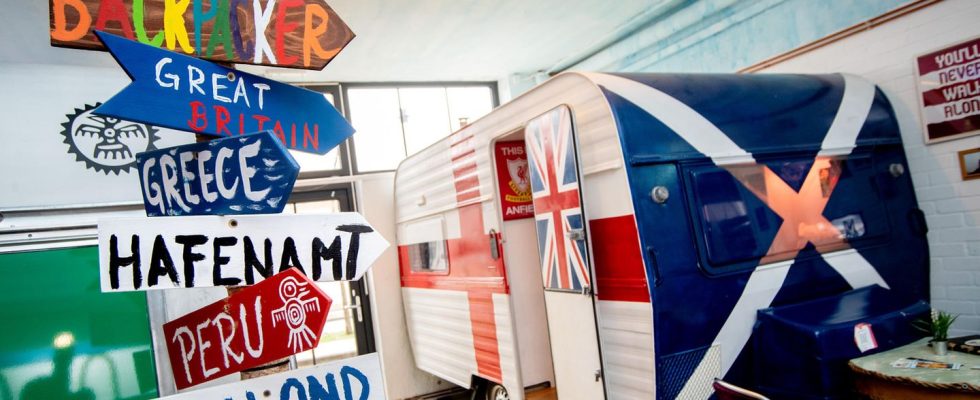Travel trend
A trip around the world in the warehouse: The trend towards indoor camping is conquering Germany
In the “Hafentraum” in Bremen, campers can experience a rather unusual adventure
© Hauke-Christian Dittrich / DPA
Camping with a difference: More and more cities in Germany are creating a new world for campers – in old warehouses or on farms.
Instead of a sleeping bag under the starry sky, camping holidaymakers can expect a bed with a slatted frame and mattress, and instead of stick bread by the campfire, a breakfast basket with rolls and juice awaits them. The weather doesn’t matter, heating and air conditioning always ensure a comfortable temperature. Only the shared bathroom is reminiscent of a usual campsite: indoor camping is the name of the concept of the “Hafentraum” in Bremen, in a former camp Eleven caravans and cabins are lined up in the warehouse.
Holidaymakers can take a trip around the world on 400 square meters. “Each caravan represents a seafaring nation,” says owner Claudia Geerken. The British camper is decorated with Liverpool FC fan merchandise, the entrance to the Canadian wooden hut is guarded by a stuffed bison and in the Finnish caravan there is a Viking sword close at hand next to the bed. “Guests can travel from country to country.”
Guests from all over the country
From Finland to South America it is only a few steps in the warehouse. A wooden walkway leads past a column painted as a lighthouse, then two deckchairs are waiting for guests of the vintage caravan “Peru”. In the car decorated with colorful plastic flowers, they should feel like they are in the jungle – and dream of being far away from the warehouse.
City travelers and cyclists spend the night here, as do families and tradesmen, says Geerken. They come from all over Germany and from abroad, up to senior age. “The last time a wheelchair user slept in a caravan.” The entire hall is sometimes rented out for school trips, company events or bachelor parties.
For the guests, the focus is on the event and the design, explains Kristina Sommer, professor of event and tourism management at the International University (IU) based in Erfurt. “A world of experiences with a connection to camping is being created here.” This form of indoor camping has little to do with camping in the traditional sense – i.e. spending the night outside without permanent accommodation.
Indoor camping throughout Germany
The concept is similar at “Indoor camping DaHeim” in the Black Forest, where guests sleep in a Christmas or jungle car, for example. According to the information, it includes 15 redesigned caravans, seven themed huts and five safari tents – covered in a former factory hall. The “Basecamp” in Bonn also offers indoor camping with an experiential character, where holidaymakers can also spend the night in a Trabi with a roof tent or in a Swiss ski gondola.
A variant of indoor camping is barn camping, says Sommer. For example, at Hofgut Stammen in the Kassel district, holidaymakers can sleep in tents set up in a barn. Pressboard between the tents provides a bit of privacy. “We have created a really rustic alternative for born soft campers,” the operators advertise. You would no longer have to worry about uncertain weather conditions, small creepy crawlies and the “unpredictable wilderness”.
And there is a third form of indoor camping, explains the professor of event and tourism management. “The focus is on room replacement.” The providers largely avoid decoration and instead rely on affordable accommodation in formerly empty halls. These include, for example, “The Dream School” in the Plön district, where holidaymakers can stay with their dogs in five huts in a former gymnasium.
Around the world in the warehouse
According to the expert, the “Hut Palace” in Berlin also falls into this category. In 2010, a Neukölln backyard factory was transformed into an indoor campsite for 46 guests. “Our basic idea was to create a place where people can actually meet each other and not just receive a key at reception and then disappear into their rooms,” is how founders Silke Lorenzen and Sarah Vollmer describe the idea. In order to be able to use the space more flexibly, they opted for “huts on wheels” – i.e. caravans.
17 images
Claudia Geerken also became aware of the concept of indoor camping in Berlin. Together with her partner, she has already run a mini golf course in a former stevedore, a theater and a fair in the basement of an old forklift shed. “The only thing we were missing was an overnight stay. It’s a shame if you have to drive home afterwards,” says the 51-year-old. They looked for caravans, developed the concept of a trip around the world and transformed the former warehouse into a theater setting.
“I really wanted to have Vietnam,” says Geerken, pointing to a shepherd’s cart decorated with bamboo and sun hats at the end of the hall. “I spent the night there on the beach with my children, and now I have a hut just like that here in Bremen.” The photos on the walls of the wood-clad car are your own holiday memories. Everyone brought in their ideas, that’s what’s special about the indoor campsite. “And of course the weather, it never rains here.”

